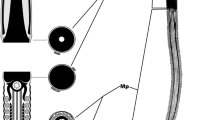Summary
Lasaea subviridis and Mysella tumida sperm resemble the primitive spermatozoan type, but exhibit several unique morphological features. L. subviridis sperm heads vary in shape and size owing to differing degrees of nuclear condensation. A fully mature, heterogenous acrosomal vesicle with an associated axial rod is present. Up to 50% of L. subviridis sperm in developing gonads have conspicuously angled flagella that propel the sperm cells in irregular helical paths. This may represent a penultimate stage in sperm development because the remainder of the sperm cells have posteriorly-directed flagella and swim in a nonhelical anterior direction. A trend toward a reduction in both nuclear condensation and swimming ability may be a long-term consequence of increasing degrees of localized, but non-internal self-fertilization in marine invertebrates that brood. Mysella tumida sperm are monomorphic and possess numerous microvilli (30–60 nm in diameter and up to 5.7 μm in length) that resemble stereocilia and radiate from the cell membrane surrounding the basal body. In this species, the sperm cell does not have an axial rod, and the complex acrosomal vesicle contains five distinct zones of varying electron opacity. One of these zones is a transverse, electron-opaque band that is apparently composed of rolled-up membrane. Following acrosomal breakdown, this membrane unfolds to cover the anterior tip of the sperm cell. Although both L. subviridis and M. tumida are hermaphroditic, the relative size of their male investments is conspicuously different. Approximately 40–50% of the M. tumida gonadal volume is testis compared with about 5% of that in L. subviridis.
Similar content being viewed by others
References
Afzelius BA (1972) Sperm morphology and fertilization biology. In: Beatty RA, Gluecksohn-Waelsch S (eds) Proceedings of the International Symposium on the Genetics of the Spermatozoon. Edinburgh, University Genetics Dept, pp 131–143
Bloom W, Fawcett DW (1975) A Textbook of Histology 10th. Ed. Saunders, Philadelphia, pp 1031
Buckland-Nicks J, Walker CW, Chia FS (1984) Ultrastructure of the male reproductive system and of spermatogenesis in the viviparous brittlestar Amphipholis squamata. J Morphol 179:243–262
Crisp DJ, Burfitt A, Rodrigues K, Budd MD (1983) Lasaea rubra: an apomictic bivalve. Mar Biol Lett 4:127–136
Deroux G (1961) Rapports taxonomiques d'un leptonacé non décrit Lepton subtrigonum Jeffreys (nomen nudum 1873). Cah Biol Mar 2:99–153
Franzén Å (1956) On spermiogenesis, morphology of the spermatozoon, and biology of fertilization among invertebrates. Zool Bidr Uppsala 31:355–482
Franzén Å (1970) Phylogenetic aspects of the morphology of spermatozoa and spermiogenesis. In: Bacetti B (ed) Comparative Spermatology. Academic Press, New York, pp 29–46
Franzén Å (1983) Ultrastructural studies of spermatozoa in three bivalve species with notes on the evolution of elongated sperm nucleus in primitive spermatozoa. Gamete Res 7:199–214
Glynn PW (1965) Community composition, structure and interrelationships in the marine intertidal Endocladia muricata — Balanus glandula association in Monterey Bay, California. Beaufortia 148 (12):1–198
Hachiri S, Higashi S (1970) Spermiogenesis in the freshwater mussel Corbicula sandai. J Educ Dept Shiga Univ Nat Sci 20:35–39 (Appendix)
Hylander BL, Summers RG (1977) An ultrastructural analysis of the gametes and early fertilization in two bivalve molluscs, Chama macerophylla and Spisula solidissima with special reference to gamete binding. Cell Tissue Res 182:469–489
Keen AM (1938) New pelecypod species of the genera Lasaea and Crassinella. Proc Mal Soc London 23:18–32
Lewis CA, Leighton DL, Vacquier VD (1980) Morphology of abalone spermatozoa before and after the acrosome reaction. J Ultrastruct Res 72:39–46
Mazia D, Schatten G, Sale W (1975) Adhesion of cells to surfaces coated in polylysine. J Cell Biol 66:198–200
Morton B (1976) Secondary brooding of temporary dwarf males in Ephippodonta (Ephippodontina) oedipus sp. nov. (Bivalvia: Leptonacea). J Conchol 29:31–39
Ockelmann KW (1965) Rediscription, distribution, biology, and dimorphous sperm of Montacuta tenella Loven (Mollusca, Leptonacea). Ophelia 2:211–221
Ockelmann KW, Muus K (1978) The biology, ecology and behaviour of the bivalve Mysella bidentata (Montagu). Ophelia 17 (1):1–93
Ó Foighil D (1985) Form, function and origin of temporary dwarf males in Pseudopythina rugifera (Carpenter 1864), (Bivalvia:Galeommatacea). Veliger 27:245–252
Ó Foighil D, Gibson AW (1984) The morphology, reproduction and ecology of the commensal bivalve Scintillona bellerophon spec. nov. (Galeommatacea). Veliger 27 (1):72–80
Oldfield E (1961) The functional morphology of Kellia suborbicularis (Montagu), Montacuta ferruginosa (Montagu) and M. substriata (Montagu), (Mollusca, Lamellibranchiata). Proc Malac Soc London 34:255–293
Pamatmat MM (1966) The ecology and metabolism of a benthic community on an intertidal sandflat (False Bay, San Juan Island, Washington). PhD Thesis Univ of Washington, pp 243
Pelseneer P (1903) (Résultats du voyage du S.Y. Belgica. Zoologie Mollusques. Buschmann, Anvers
Ponder WF (1971) Some New Zealand and SubAntartic bivalves of the Cyamiacea and Leptonacea with descriptions of new taxa. Rec Dom Mus NZ 7 (13):119–141
Popham JD (1979) Comparative spermatozoon morphology and bivalve phylogeny. Malacol Rev 12:1–20
Schroeder TE, Christen R (1982) Polymerization of actin without acrosomal exocytosis in starfish sperm. Exp Cell Res 140:313–371
Smith TB (1983) Tentacular ultrastructure and feeding behaviour of Neopentadactyla mixta (Holothuroidea: Dendrochirota). J Mar Biol Assoc UK 63:301–311
Strathmann RR, Strathmann MF, Emson RH (1984) Does limited brood capacity link adult size, brooding and simultaneous hermaphroditism? A test with the starfish Asterina phylactica. Am Nat 123 (b):796–818
Tilney LG, Hatano S, Ishikawa H, Mooseker MS (1973) The polymerization of actin: its role in the generation of the acrosomal process of certain echinoderm sperm. J Cell Biol 59:109–126
Tilney LG, Kichart DP, Sardet C, Tilney M (1978) Polymerization of actin IV. Role of Ca++ and H+ in the assembly of actin and in membrane fusion in the acrosomal reaction of echinoderm sperm. J Cell Biol 77:536–550
Author information
Authors and Affiliations
Rights and permissions
About this article
Cite this article
Ó Foighil, D. Fine structure of Lasaea subviridis and Mysella tumida sperm (Bivalvia, Galeommatacea). Zoomorphology 105, 125–132 (1985). https://doi.org/10.1007/BF00312147
Received:
Issue Date:
DOI: https://doi.org/10.1007/BF00312147




